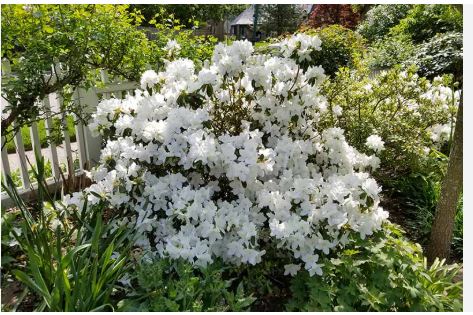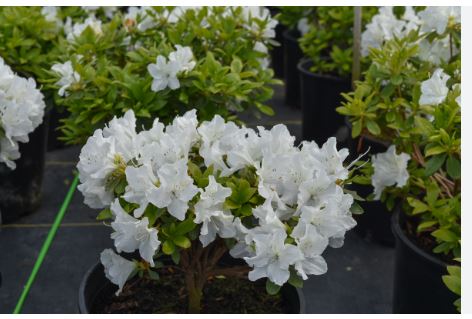
Azaleas are flowering shrubs known for their vibrant, colorful blooms. They are closely related to rhododendrons and are often found in gardens, woodland borders, and even in pots. Azaleas can be deciduous or evergreen, and they are generally smaller than rhododendrons, with thinner leaves and funnel-shaped flowers.
Azaleas bloom in the spring (April and May in the temperate Northern Hemisphere, and October and November in the Southern Hemisphere), their flowers often lasting several weeks. Shade tolerant, they prefer living near or under trees. They are part of the family Ericaceae.Azaleas actually look the most attractive when they are planted alone. But mass plantings work well in larger areas, such as wooded sites.
Azaleas are generally slow-growing. They need at least four hours of sunlight daily and afternoon shade in places with scorching summers. Keep their soil moist, acidic, and fertile for them to grow well. Fertilizer needs are low. Some species need regular pruning. Azaleas are native to several continents including Asia, Europe and North America. They are planted abundantly as ornamentals in the southeastern US, southern Asia, and parts of southwest Europe.
Azaleas shrubs are best planted in the spring or early fall. Growth rates vary by species, but most are relatively slow-growing. A one-gallon container plant usually will flower in its first year but may take as much as 10 years to reach its full size. Azaleas are toxic to humans and animals.

Evergreen White Azaleas
‘Delaware Valley White’ (Kurume Hybrid)
- Description: A compact evergreen with clusters of pure white, single blooms.
- Size: 3–4 feet tall, 4–5 feet wide.
- Features: Early to mid spring blooms, dense foliage, cold-hardy (USDA zones 6–9). Ideal for borders or hedges.
- Care: Partial shade, acidic soil (pH 4.5–6.0), consistent moisture.
‘Gumpo White’ (Satsuki Hybrid)
- Description: A low, spreading evergreen with large, ruffled white flowers, perfect for containers or ground cover.
- Size: 1–2 feet tall, 2–3 feet wide.
- Features: Late spring to early summer blooms, zones 7–9, suited for small gardens or bonsai.
- Care: Partial shade, well-drained acidic soil, minimal pruning.
‘Girard’s Pleasant White’ (Girard Hybrid)
- Description: A cold-hardy evergreen with pure white, slightly fragrant flowers in dense clusters.
- Size: 2–3 feet tall and wide.
- Features: Mid spring blooms, glossy foliage, zones 5–8, great for northern climates.
- Care: Partial shade to full sun in cooler zones, acidic soil, mulch to retain moisture.
‘Bloom-A-Thon White’ (Bloom-A-Thon Hybrid)
- Description: A reblooming evergreen with creamy white flowers, blooming in spring, summer, and fall.
- Size: 3–4 feet tall, 3–5 feet wide.
- Features: Zones 6–9, extended bloom season, ideal for continuous color in mixed beds.
- Care: Partial shade, well-drained acidic soil, fertilize lightly in spring.
‘Treasure’ (Glenn Dale Hybrid)
- Description: A vigorous evergreen azalea with large, pure white, single blooms and a slightly open growth habit.
- Size: 4–6 feet tall, 4–5 feet wide.
- Features: Mid spring blooms, zones 6–9, developed by the USDA for disease resistance. Suits mixed borders or as a specimen plant.
- Care: Partial shade, acidic soil (pH 4.5–6.0), well-drained, regular watering.
‘Mrs. Nancy Dippel’ (Southern Indica Hybrid)
- Description: A robust evergreen with large, ruffled white flowers, often with a faint yellow throat.
- Size: 4–6 feet tall, 5–7 feet wide.
- Features: Early to mid spring blooms, zones 7–10, thrives in warmer climates, ideal for hedges or screens.
- Care: Partial shade to filtered sun, acidic soil, mulch for moisture retention.
‘Alba Magna’ (Kaempferi Hybrid)
- Description: A semi-evergreen to evergreen azalea with clusters of pure white, slightly fragrant flowers.
- Size: 3–5 feet tall, 3–4 feet wide.
- Features: Mid spring blooms, zones 5–8, cold-hardy, compact for smaller gardens or containers.
- Care: Partial shade, acidic soil, protect from harsh winter winds.
‘Autumn Ivory’ (Encore Hybrid)
- Description: A reblooming evergreen with bright white, single blooms, flowering in spring, summer, and fall.
- Size: 2.5–3 feet tall, 3–3.5 feet wide.
- Features: Zones 7–10, dwarf habit, perfect for small spaces or mass plantings.
- Care: Partial shade, well-drained acidic soil, fertilize lightly after each bloom cycle.
Deciduous White Azaleas
‘Northern Lights White’ (Northern Lights Hybrid)
- Description: A cold-hardy deciduous azalea with fragrant, pure white flowers.
- Size: 3–5 feet tall and wide.
- Features: Early spring blooms, zones 3–7, developed for extreme cold tolerance, vibrant fall foliage.
- Care: Partial shade, acidic soil, tolerates wetter conditions.
Rhododendron viscosum ‘Snowbird’ (Swamp Azalea)
- Description: A native deciduous azalea with highly fragrant, white to pale pink blooms.
- Size: 5–8 feet tall, 4–6 feet wide.
- Features: Late spring to early summer blooms, zones 4–9, thrives in wet soils, ideal for rain gardens.
- Care: Partial shade, moist acidic soil, attracts pollinators.
‘Weston’s Innocence’ (Weston Hybrid)
- Description: A deciduous azalea with fragrant, pure white, tubular flowers.
- Size: 4–6 feet tall, 3–5 feet wide.
- Features: Late spring blooms, zones 4–8, vibrant orange-red fall foliage, ideal for woodland gardens.
- Care: Partial shade, moist acidic soil, attracts pollinators like bees and hummingbirds.
Rhododendron canescens ‘Varnadoe’s Phlox Pink’ (Piedmont Azalea)
- Description: A native deciduous azalea with white to very pale pink, fragrant blooms, often considered white in certain lights.
- Size: 6–10 feet tall, 5–8 feet wide.
- Features: Mid to late spring blooms, zones 5–9, native to southeastern U.S., suits naturalized landscapes.
- Care: Partial shade, moist acidic soil, tolerates wet conditions.
‘Snowflake’ (Exbury Hybrid)
- Description: A deciduous azalea with large, fragrant, creamy white flowers and a hint of yellow in the throat.
- Size: 4–6 feet tall, 4–5 feet wide.
- Features: Mid spring blooms, zones 5–8, stunning red-orange fall foliage, great for mixed shrub borders.
- Care: Partial shade, acidic soil, water during dry spells.
Specialty White Azaleas
‘Autumn Moon’ (Encore Hybrid)
- Description: A reblooming evergreen with soft white, single blooms tinged with pale yellow.
- Size: 3–4 feet tall, 3–4 feet wide.
- Features: Blooms in spring, summer, and fall, zones 7–10, perfect for warm climates.
- Care: Partial shade, well-drained acidic soil, regular watering during bloom cycles.
Rhododendron atlanticum ‘Silver Cloud’ (Coastal Azalea)
- Description: A native deciduous azalea with fragrant, creamy white flowers and a compact habit.
- Size: 3–5 feet tall, 3–4 feet wide.
- Features: Mid to late spring blooms, zones 5–8, native to eastern U.S., attracts hummingbirds.
- Care: Partial shade, acidic soil, tolerates sandy or coastal conditions.
Rhododendron austrinum ‘Escatawpa’ (Florida Azalea)
- Description: A native deciduous azalea with creamy white to pale yellow-white, fragrant flowers.
- Size: 6–8 feet tall, 5–7 feet wide.
- Features: Early to mid spring blooms, zones 6–9, native to southeastern U.S., attracts butterflies and hummingbirds.
- Care: Partial shade, well-drained acidic soil, tolerates sandy soils.
General Care Tips for White Azaleas
- Light: Partial shade is ideal; white blooms can fade in intense sun, and too little light reduces flowering.
- Soil: Acidic (pH 4.5–6.0), well-drained, rich in organic matter.
- Watering: Maintain consistent moisture, especially during bloom periods; mulch to prevent drying out.
- Pruning: Prune lightly after spring bloom to shape; avoid heavy cuts to preserve next season’s buds.
- Fertilizer: Use fertilizer for acid-loving plants in early spring; over-fertilizing can harm blooms.
N/B
- Azaleas are technically Rhododendron species, but the term “azalea” refers to specific subgroups with smaller leaves and more delicate flowers.
- Evergreen varieties dominate in warmer climates (zones 7–10), while deciduous types are better for colder regions (zones 3–6).
- Hybrids like Encore and Bloom-A-Thon are popular for extended bloom seasons, especially in modern landscaping.
- Native azaleas are excellent for ecological gardens, supporting local pollinators like bees and hummingbirds.
- These additional white azaleas complement the earlier list by offering diverse sizes and bloom times, from dwarf rebloomers like ‘Autumn Ivory’ to tall natives like ‘Escatawpa’.
- Evergreen types (‘Treasure’, ‘Mrs. Nancy Dippel’) are excellent for year-round structure, while deciduous varieties (‘Weston’s Innocence’, ‘Snowflake’) add seasonal drama with fall color.
- Native azaleas (‘Varnadoe’s Phlox Pink’, ‘Escatawpa’) are ideal for ecological gardens, supporting local pollinators.
- Reblooming hybrids like ‘Autumn Ivory’ are perfect for prolonged color in warmer climates (zones 7–10).